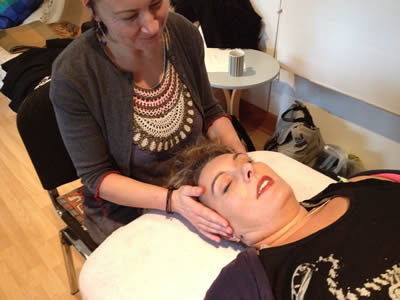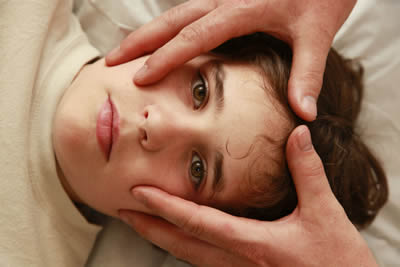Positive Health Online
Your Country

Structure and Function in Craniosacral Therapy
by Jonathan Lawrence(more info)
listed in craniosacral therapy, originally published in issue 192 - March 2012
Craniosacral therapy owes a huge debt to those visionaries originally from the osteopathic profession, who combined an intuitive understanding of the nature of the human organism with scientific knowledge and understanding.
Andrew Taylor Still, the Founder of Osteopathy, realized that structure and function are two sides of the same coin. If the structure is disturbed then function becomes less efficient. Similarly if function changes, then structure is modified to take account of the new needs.
This can be illustrated in trained athletes. Rebecca Romero won Olympic medals in two different sports, rowing and subsequently cycling. Although both sports require a high level of aerobic fitness, stamina and power it required her to literally remodel her physiology, such as demands on specific muscle groups to adapt to the different demands of each sport.
This also occurs in everyday life. Occupations such as manual labour or deskwork create very different physiological demands on our structures, in that over a period of years our systems become very well adapted to our lifestyles. The downside of repetitive use is that our bodies wear differentially due to repetition giving rise to repeated micro-trauma over a long period of time.
William Garner Sutherland, a student of Still's, applied the same concept of structure / function relationships to his discovery of what is now called the involuntary mechanism. This motion, which occurs throughout the body, has been associated with motility of the central nervous system and flow of cerebro-spinal fluid. It drives the motion felt in the bones of the skull and fascia.
This palpable movement allows the skilled craniosacral practitioner to measure the rate, amplitude and qualities of the motion within an individual and relate his/her findings to functional and structural disturbances with the system of the patient. With practice and experience, the practitioner can make quite accurate judgments as to the state of the tissues palpated and to the cause of any disturbance.
A simple example would be palpation of the thoracic inlet in which the practitioner, with the patient supine has his/her hands on the upper thorax, the lower hand between the scapulae and the upper hand on the sternum. A sense of compression from the sternum posteriorly may well indicate a seatbelt injury such as is sustained in a motor accident. Similarly, falls onto the base of spine may give rise to a palpable upwards compression through the sacrum.
With experience, the practitioner can get a sense of the age and severity of the causal trauma. In addition, the degree of palpated disturbance and the nature and extent of tissue disturbance can show how the body has absorbed the forces causing the trauma, and how the body has subsequently adapted giving rise to the presenting symptomatology.
This tissue memory invariably has an emotional component. Indeed, some authorities believe that the emotional reaction to the trauma is the key element in the body retaining the tissue disturbance. This idea is supported by the frequent emotional release that can occur concurrently or subsequently following treatment.
As can be readily seen from the above example of sternal compression, the release of the trauma within the tissues can make a significant improvement in function. In this example, symptoms such as neck stiffness and headaches often improve with such treatments. We can also postulate that the reduction in tension within the connective tissue will benefit vascular efficiency, including lymphatic drainage of the thoracic area and will also mean that the local soft tissues such as muscles and fascia can lengthen. All this structural improvement will thus benefit local function.
More subtly, the alteration in tone will also affect the efficiency of the extra cellular matrix (ECM), which is crucial in communicating between cells and the outside, bringing in nutrients and removing toxins. In fact Oschman calls the ECM and cells together the Living Matrix, pointing out that cells are not in any sense autonomous but are in constant and dynamic communication with the rest of the organism via the ECM.
We can now see how structure can disturb function down to the cellular level and how this can be a factor in the aetiology of disease. This process, which can lead to the development of pathological changes and organic disease, can take many years; approaches such as craniosacral therapy can, by helping to restore the integrity of the tissues, slow or even reverse this process.
Using the example above over a period of time, the compression of the sternal tissues and fascia will restrict the efficiency of rib movement and set up nerve reflex disturbances which can have a knock on effect on the whole segment including the sympathetic nerves to the heart and lungs, again compromising function. This may, therefore explain the incidence of myocardial infarctions in the absence of organic disease through sympathetic mediated vasoconstriction of the coronary arteries.
As altered structure affects function ,so altered function affects structure. The Rebecca Romero case reminds us that functional demands stimulate structural changes. Athletes develop larger muscles suited to the demands of their occupation. The heart pumps a greater volume of blood per contraction to cater for the demand. The muscles and nervous system are developed and adapted to athletic needs of the individual. So structure and function are two sides of the same coin in effect.
Craniosacral therapists intervene when this relationship is disturbed through trauma or disease and the body's self-balancing homeostatic mechanisms fail.
Failure of the homeostatic mechanisms means retention of disturbed structure / function, even when the original cause has gone. This results in a tissue memory effect in which the tissue behaves as if the originating disturbance is still present. The rest of the organism then has to adapt and compensate for the modification in function, reducing the ability of the body to cope with other challenges. An example of this would be a tilt in the pelvis occurring after a bending, twisting and lifting injury. Here the sacro-iliac joint has stuck on one side. This requires the spine to develop a series of compensatory curves in order to keep the body upright, with concomitant side-flexing and rotating of the spine and shortening of the soft tissues in the concavities and lengthening in the convexities.
The nervous system adapts via modifications of reflex arcs Assuming the injury is not adequately dealt with as the acuteness of the injury subsides, these compensations may go unnoticed as they are rather subtle. Eventually these patterns can give rise to symptoms away from the original injury such as in this type of example, headaches. Symptomatic treatment is then either temporary at best, or ineffective at worst.
In making sense of the pattern, craniosacral therapists refer to the original disturbance as being the Primary and the compensations as being Secondary. Until the primary cause is dealt with, the symptoms will tend to recur with various degrees of severity depending on other factors.
Most people will experience a number of traumas in their life with the establishment of a number of compensatory patterns. The patient therefore presents with a number of these compensatory patterns each with a Primary, interfering with each other giving rise to a number of symptoms of varying intensity.
The longer the patterns have been present, the greater the degree of adaptation and the more that aspects of the organism's structure will have been irrevocably changed. Pathological changes such as spondylosis of the spine due to the resulting altered mechanics may be irreversible; the best that can be achieved with treatment is a reduction in the rate of pathological change in this instance, or even some tissue repair if possible.
In those cases of severe chronicity where a great deal of adaptation has given rise to pathological change with irreversible structural modifications, the secondary adaptations are then more relevant in maintaining the condition of the patient. In this case the Primary can be defined as the structural factor that is most important in maintain the presenting pattern.
Once this has been resolved, a new pattern emerges with a new Primary, which is in turn treated. Thus the practitioner works through the layers of problems until the optimum state is achieved. The treatment is then concluded, or if necessary, a maintenance regime is instigated.
The concept of layers of disturbance has similarities with other holistic disciplines such as homeopathy with Hering's law of cure.
The challenge for the practitioner is to make sense of what is presented and to devise a treatment regime with the aim of restoring optimum function. This will, in all likelihood, involve a course of treatments with the skill of the practitioner being to manage the transition to the optimum state in as fast and as pain free a manner as possible.
A key principle of treatment in craniosacral technique, which is shared by all complementary therapies, is that the body has a tendency to heal itself. If the craniosacral practitioner identifies the structure / function disturbances and deals with them, then the patient's own self healing and homeostatic systems do the rest of the work.
Further Reading
Sutherland, William Garner. Teachings in the Science of Osteopathy : Rudra Press. 1990.
Upledger J, Vredevoogd J. Craniosacral Therapy, Seattle: Eastland Press. 1983.
Oschman, James L. Energy Medicine the Scientific Basis Edinburgh: Churchill Livingstone. 2000.
Comments:
-
No Article Comments available